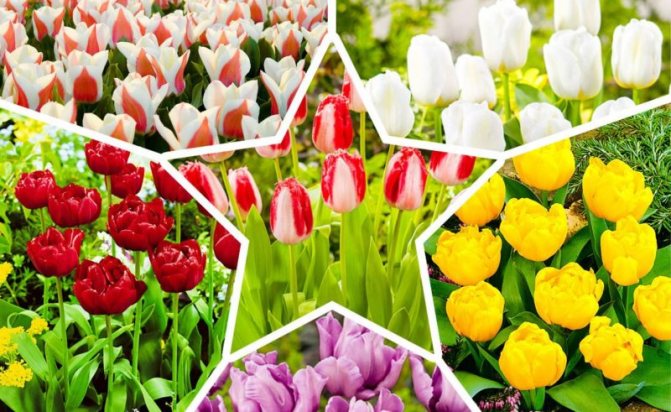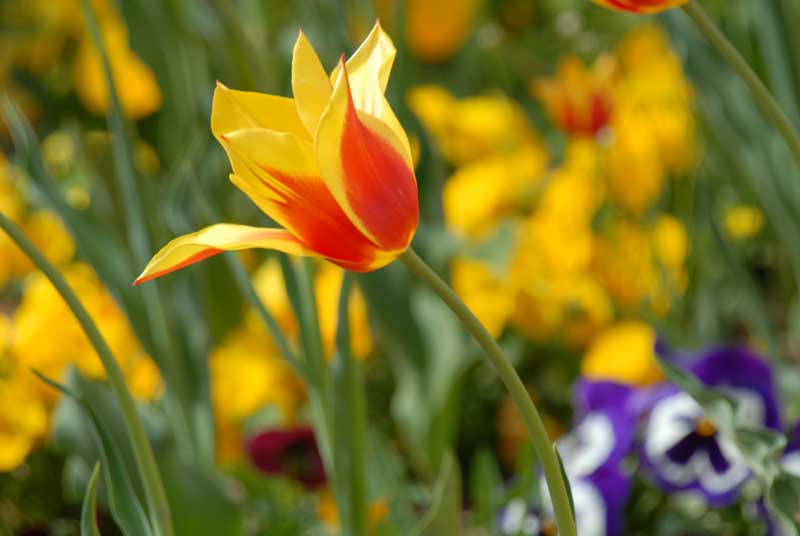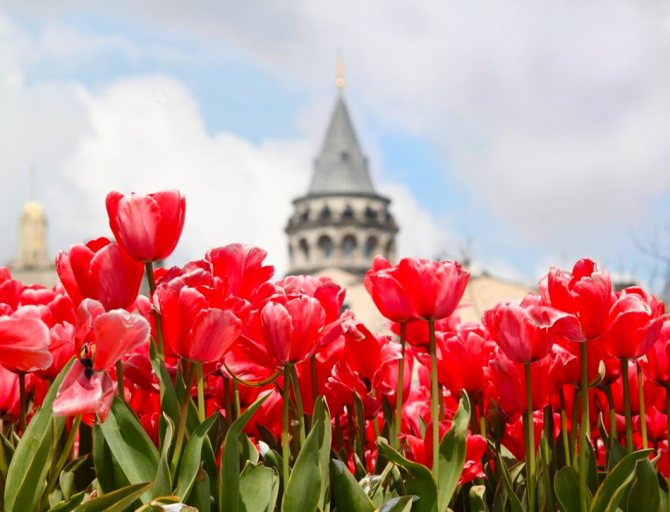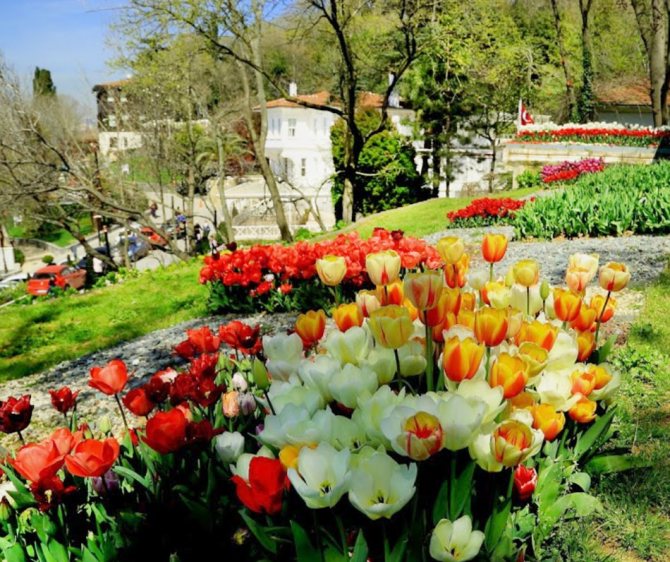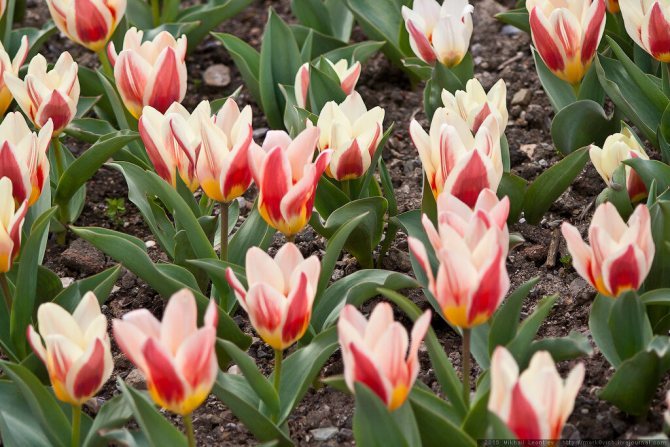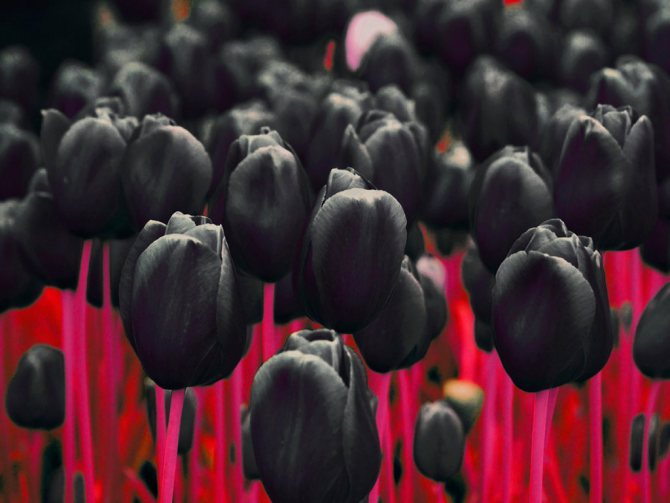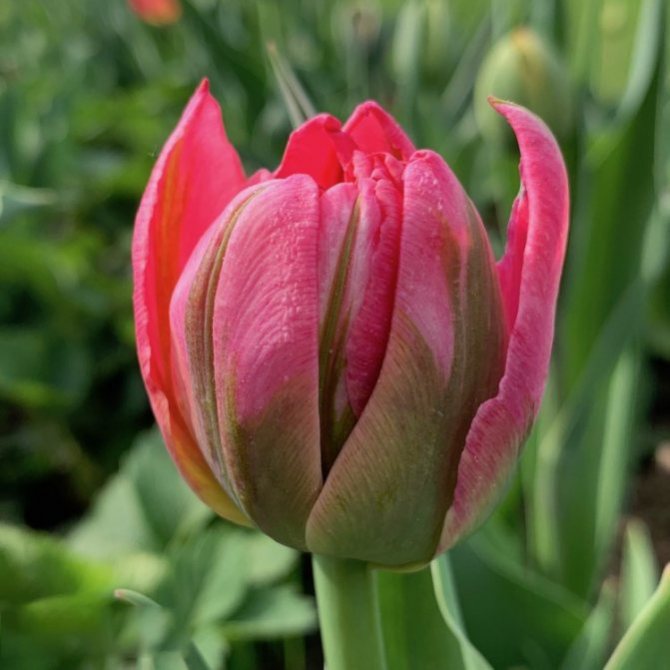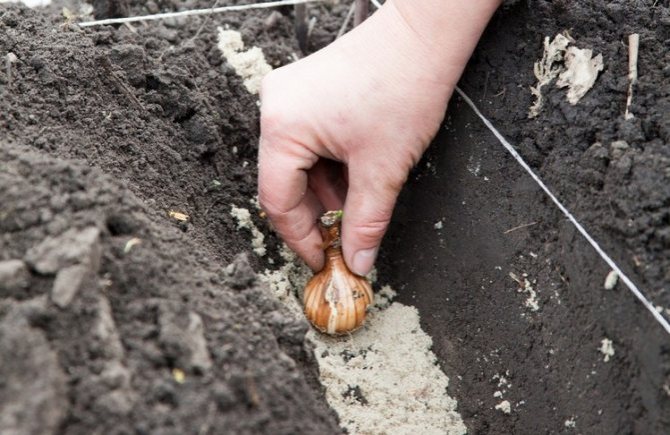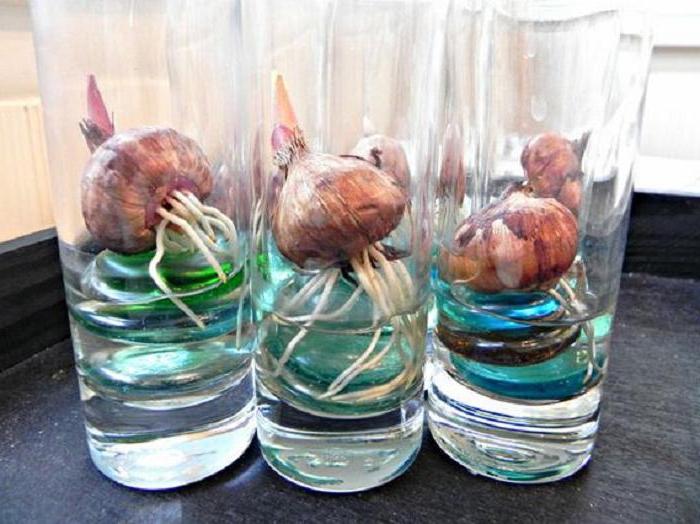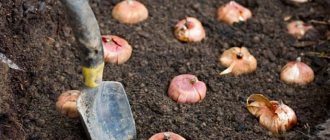May 10. Tulips in full bloom! At grandmother's dacha, they grow in abundance - a whole garden bed. It should be said, however, that spring is warm today (2016), early ripening. Everything is dismissed much earlier. So, tulips usually bloomed for the birthday of the niece (May 13). This year, Baba Tanya worries that there will be no bouquet - the tulips will already fade. An unambiguous answer to the question "When do tulips bloom?" - in the spring, at the beginning of May. More exact dates depend on the region (we live in central Russia, Yaroslavl region).
How many days do tulips bloom?
Blooming of tulips outdoors, without treatment with special chemicals, usually lasts an average of 1 week. In the photo taken on May 6, only the buds are visible:

On May 7, the following began to unfold:
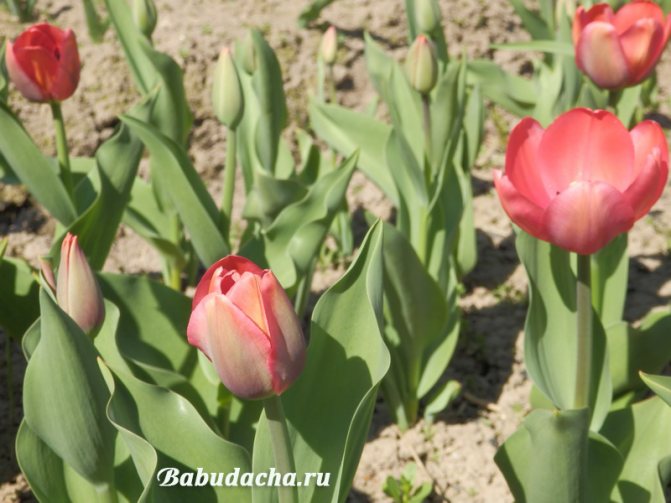

9th May, when the tulips are in bloom at it's peak. So, most likely, they will fade on May 13-14.


We care for flowers with love, which is why flowers are pleasing to the eye from year to year
Many gardeners are interested in how much tulips bloom. This is influenced by many circumstances, which are necessary to have a complete understanding in order to grow good flowers. It is necessary to take into account all the nuances, from the choice of seedlings and planting to regular activities aimed at extending the flowering period of tulips.


Favorable planting days according to the calendar in 2020
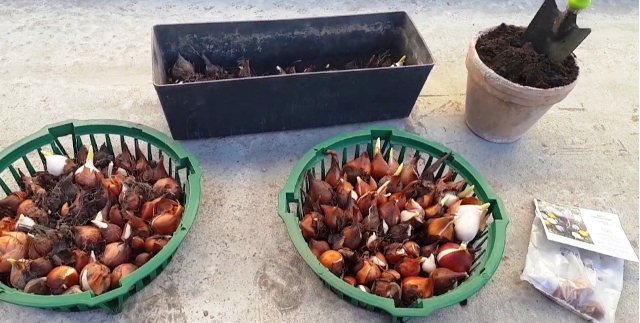

When to plant tulips, you can find out from the lunar calendar. The table shows the optimal and unwanted days for planting bulbs in 2020:
| Month | Auspicious days | Bad days |
| January | 7-9, 15-19, 27-29 | 2, 3, 10, 25, 31 |
| February | 1-4, 6, 7, 12-15, 19, 20, 24, 25, 28, 29 | 8, 9, 21, 22, 26, 27 |
| March | 2-6, 11-14, 17, 18, 22, 23, 27, 28 | 7, 8, 19-21, 25, 26 |
| April | 1, 2, 6-10, 12, 13, 18, 19, 24, 28, 29 | 3, 4, 15-17, 20-22, 30 |
| May | 5-7, 10-12, 15, 16, 20, 25, 26, 30, 31 | 1, 13, 14, 18, 21, 27-29 |
| June | 1-4, 7, 8, 12, 17-19, 22, 23, 28-30 | 9-11, 14-16, 24, 25 |
| July | 1, 2, 4-6, 9, 10, 14, 15, 23, 25-28 | 7-8, 11-13, 21, 22 |
| August | 1, 2, 5-7, 11-13, 15-16, 22-26, 28, 29 | 3, 4, 8, 9, 17, 18, 30, 31 |
| September | 1-3, 6-9, 11-13, 18-25, 29, 30 | 1, 4, 5, 14, 15, 26, 27 |
| October | 4, 5, 9, 10, 14, 15, 17, 18, 21-23, 26, 27, 31 | 1-3, 16, 24, 25, 28-30 |
| November | 1, 2, 4-6, 12, 13, 22-24, 27-29 | 7-9, 14, 15, 25, 26 |
| December | 1-3, 8-10, 12, 15, 16, 25-31 | 5, 6, 14, 17-19, 22-24 |
Classification of tulips by flowering time
There is an official classification of tulips in 4 groups depending on the time of the beginning of flowering - early flowering, medium flowering, late flowering and a separate group - botanical and specific. Each group within itself is divided into several more classes.
Early flowering
They bloom mainly at the end of April, are subdivided into simple and terry, which indicates the peculiarities of the structure of the inflorescence:
- in simple ones, the diameter of the inflorescence varies from 25 to 40 cm, the most popular form is a glass, among the famous varieties are Golden Harvest, Golden Olga of golden color;
- Terry varieties are yellow or red, bloom for a long time, varieties are widespread - Shunord, Electra.
Mid-flowering
They bloom in an average time from mid-April to mid-May, 2 classes stand out - Triumph, Darwin hybrids, each of which has its own characteristics:
- Triumph - the spectacular appearance of flower stalks in the form of a glass up to 70 cm long, a variety of all kinds of shades from white to purple, the most often planted varieties are Snowstar, Crater;
- Darwin's hybrids grow up to 80 cm, the diameter of the inflorescences is more than 10 cm, among the advantages of plants are frost resistance, strong immunity to the variegated virus, among the popular varieties are Vivex, Apeldoorn.


Late blooming
The largest group, bloom from the second half of May, includes 7 classes - Simple late, Terry late, Fringed, Lily, Green, Rembrandt, Parrot.
Each class deserves a separate consideration.
- Simple late ones - stretching up to 75 cm. The structure of the inflorescence is goblet with a square base, the shades are varied - from light to black, there are multicolored tulips. Dillenburg and Bacchus varieties are often planted.
- Terry late - often called peony because of the similarity with this flower in a double inflorescence. The height of the plants is average, the shades vary, the varieties are loved by summer residents - Eros, Nice.
- Fringed - they are characterized by petals with needles along the edges, resembling a fringe. Plant height and color differ by cultivar. These flowers are often grown for cutting, among the famous varieties - Flamenco, Liska.
- Lily-colored - the name speaks for itself, flower buds with petals turned outward are very similar to lilies. Inflorescences can lose their shape in heavy rain. The most popular varieties are Jacqueline, West Point.
- Greens are a relatively new class. Flowers are always two-colored - green center and petals of various shades - white, pink, red, the buds are cup-shaped. Gardeners' favorite varieties are Golden Artist, Sprin Green.
- Rembrandt is a small class, a distinctive feature of which is the spots on the buds. The shape of the inflorescence is a glass. A popular variety is Absalon.
- Parrots are flowers of extraordinary appearance. You can notice a clear resemblance to the plumage of a parrot in the form of openwork petals, which are painted in various shades. There are many multicolored tulips, one of the commonly planted varieties is Fleming Perroth.
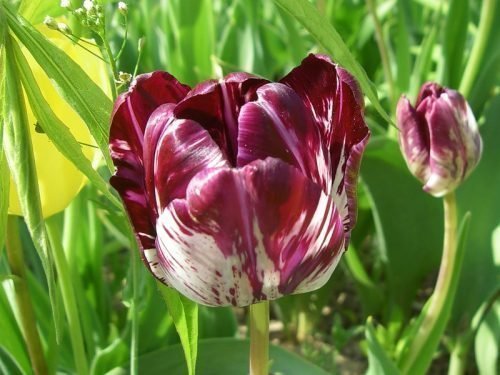

Botanical and species
This group includes a variety of hybrids that bloom very early, belong to wild-growing species, and when flowering tulips acquire bright colors.
The most common classes are:
- Kaufman tulips are used to decorate alpine slides due to their low height, they have good immunity against diseases and pests, close to it variety Korona, the inflorescence of which is similar to the crown;
- Foster's tulips - flowers are larger than the representatives of the previous group, the shape of the inflorescences can be goblet and cupped, the main colors of the petals are red and pink, the flowers are highly resistant to the variegation virus;
- Greig's tulips - this includes not only Greig's tulips, but also their hybrids, their height is small, but large inflorescences, speckled leaves are interesting, the color of slightly bent petals is mostly red, orange.
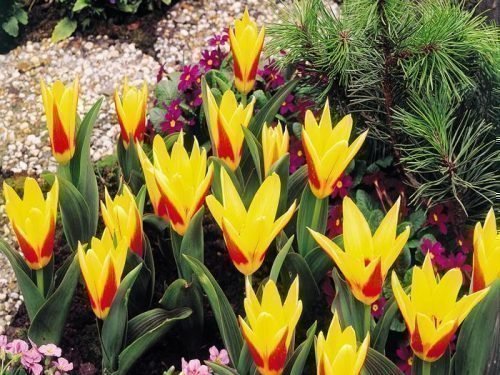

The influence of lunar phases on tulip crops
Having fully understood the procedure for planting tulips, it is necessary to decide on the date of its carrying out. As mentioned above, these plants are planted from mid-September to the end of October, however, specific days can only be determined using the lunar calendar. This method has become especially popular in recent years.
This technique is based on lunar cycles that repeat from month to month. It is known that the Earth's satellite acts on fluids on our planet - the phenomenon of ebb and flow is associated with lunar activity. Since plants are mostly moisture, the cycles of the moon affect them as well.
So, during lunar liquid growth plants and nutrients dissolved in them move from the root system to the stem. At the same time, active growth of the aerial part is observed, fruits and young shoots are formed.
Reproduction
Tulips reproduce by bulbs and seeds, the first option is the most acceptable, only specialists can successfully cope with the second, because when tulips bloom, they do not inherit the characteristics of the parent plant.
When propagating by bulbs after flowering tulips, the parent plant dies, it is replaced by a daughter plant with developing children. Their number is influenced by several circumstances, among which the main one is the ecological situation.
To prevent tulip degeneration, it is necessary to use topper bulbs with an average diameter of 12 cm for planting, they retain all the features of this plant variety.
Luxury bouquets
White tulips go well with red and orange cousins, and yellow ones look good with irises. Original compositions are also obtained when combined with blue flowers. For example, amazing wedding bouquets with snow-white tulips will be obtained by adding azure hydrangeas to them. Such compositions are best of all unobtrusively emphasizing the gentle and romantic image of the bride.
Contrasting compositions are often preferred, in which varieties with delicate shades of petals are combined with bright colors. Particularly careful selection requires the composition of bouquets with similar shades of tulips. These colorful flowers are almost odorless (in Persian manuscripts they were compared to a bright peacock without a beautiful voice), therefore, they are especially popular when decorating rooms.
We advise you to look at the most interesting article about the most beautiful bouquets in the world.
Read more: Siberian tomato early ripening characteristics and description of the agricultural technology variety
Planting
When a tulip will bloom depends on many factors, ranging from the correct timing of planting the bulbs. The most suitable time is autumn, a specific period is chosen based on the climate of the region. The average rooting time of the bulbs is from 3 weeks to 1 month.
With spring planting, the rooting period will stretch for a long time. The main indicator of planting readiness is the soil temperature, which should approach 10 ° C, in most territories this time comes in mid-September. You can grow tulips outdoors and in greenhouses.
The bulbs should be planted according to varieties, carefully examining them, getting rid of rotten, sick and old specimens. Immediately before placing in the ground, the bulbs should be dipped in a solution of potassium manganese for 20-30 minutes.
Requirements for the place and order of landing:
- enough sunlight during the day;
- sandy loam soil with neutral or weak acidity;
- the soil should be light;
- high-quality drainage is required;
- you need to add compost, wood ash before planting;
- the depth of immersion in the soil is determined by the size of the bulb and should be 3 of its diameters;
- careful mulching with peat, sawdust, foliage, straw is necessary.
Read also: What is made from common barberry
After planting, the flowers appear in about six months, after 20-30 days they bloom.
The average duration of a tulip's bloom is 7-10 days. Cut tulips last 7-12 days.
For the first time, a tulip blooms only 5-6 years after planting. Lush bloom is observed 8-10 years after planting.
Tulips of the steppes of the Saratov region
There are spacious steppes where tulips grow in the Saratov region. The inhabitants of these places can boast of a unique natural rarity of flora. Tulips have taken root here since the post-glacial period, since the formation of the steppes.
There are 4 types of wild tulips: Bieberstein, two-flowered, drooping and Schrenk.
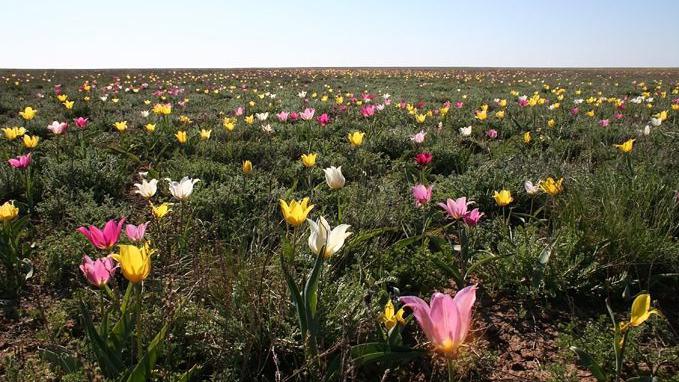

The most common of them and the smallest in size is the golden-yellow Bieberstein tulip, which is also found in other regions of Russia.
Unfortunately, there are few steppe tulips left today due to the fact that they reproduce by seeds (not tubers). And they begin to bloom seven years after germination from the seed. Therefore, steppe tulips are listed in the Red Book.
Growing rules
A few simple guidelines will simplify the growing process and help you get beautiful and long-blooming tulips:
- for planting, you need to choose an area where tulips have not grown for the last 3 years;
- when the flower grows intensively, you need to feed it at least 3 times;
- digging up the ground near the plants should be extremely careful to avoid damage to the leaves or root system;
- when cutting a blooming tulip, it is necessary to leave 2 leaves, which can provide food for the bulb, in the future such a bouquet will stand for many days;
- to prevent the decay of a large bulb into small parts, a wilted plant should be plucked before the fruit ripens - a capsule, this procedure will allow you to wait for large tulips next year.
Care measures
In order for tulips to bloom faster and flowering times to be long, special attention should be paid to each care measure.
Watering
When the plants emerge, they all need careful inspection. If there are no sprouts, then it is better to get rid of the bulbs due to the high likelihood of diseases, such specimens will definitely not bloom.
The most important procedure is watering, the frequency and volume of which increases with budding and flowering. The average irrigation rate is 15-40 liters of water per 1 sq. m. It is necessary to control that moisture fully reaches the root system, but it is necessary to avoid getting it on the leaves.
Fertilization
For tulips, fertilizers dissolved in water are most preferred, but leaves should be dry when feeding to prevent subsequent burns. Also, for the full flow of nutrients into the soil, it is recommended to water it after fertilizing.
Optimal feeding schedule:
- a few days after the formation of at least one sprout in early spring, it is necessary to apply dry fertilizers, which should be scattered near the bushes, it is advisable to use a mixture of phosphorus, potassium, nitrogen;
- during budding, it is necessary to add a mixture of potassium, phosphorus and add nitrogen, but it should be 2 times less than the other components;
- after the tulips have faded, potassium and phosphorus should be added to the ground at the rate of 30-35 g per 1 sq. m .;
- for the early formation of daughter bulbs, it is necessary to add zinc and boron to the soil.
Weed removal, loosening
These two events are closely related to each other. Weeds take nutrients from the growing flowers; it is easiest to pull the weeds out after watering.
Constant loosening of the soil can significantly reduce the amount of weeds, prevent the evaporation of the liquid necessary for growing tulips. Withered tulips should be removed immediately, then all efforts will be spent on increasing the weight of the bulbs, and not on developing the seeds.
Communities ›Interesting to know ...› Blog ›Do you know how many petals a flower has?
The number of petals in chamomile tends to 21 or 34, these are numbers from the Fibonacci series
Interestingly, the number of spirals on plants, in which each new primordium forms at a golden angle (the so-called golden angle, which is approximately 137.5 degrees, allows the ideal location of new primordia to be achieved) to the previous one, coincides surprisingly closely with the Fibonacci numbers. This series of numbers was first described by the 13th century Italian mathematician Leonardo Fibonacci. In this row, each subsequent number after 1 is equal to the sum of the two previous ones: 1, 1, 2, 3, 5, 8, 13, 21, 34, 55, and so on.
The number of branches corresponds to the Fibonacci numbers
Flowers of many plants, which have a spiral pattern, the number of petals often corresponds to the numbers from the Fibonacci series. Many have observed that the buttercup, as a rule, has 5 petals, the canadian wolf's foot has 8, the madagascar rosewort has 13, the aster has 21, the common field daisy has 34, and the wild aster has 55 or 89. In the structure of some fruits and vegetables can also be seen Fibonacci numbers. For example, a banana has a pentahedral cross-section.
More about the golden angle - it is noteworthy that computer visualization of the model of the development of primordia (leaf bud in the form of a tubercle or roller) from the central growth cone shows that a spiral is formed only if the angle between each new formation corresponds with high accuracy to the value of the golden angle ... A deviation from this angle by only one tenth of a degree will immediately destroy the entire structure.
Care of faded plants
After the end of the flowering of tulips, it is necessary to carry out certain activities:
- water the wilted flower for another 2-3 weeks, gradually reducing the amount of liquid;
- fertilize the land with phosphorus, potassium;
- refrain from pruning the plant;
- after wilting of the stem, the leaves of the bulb must be pulled out.
Only varieties of red tulips are suitable for being in the soil in the summer, the rest of the varieties should be dug out without fail when the stems become flexible and the leaves dry out.
If the bulbs are left in the ground, then the size of the flowers in the next season will decrease significantly, the reason is the deepening of the mother bulb, which pushes the baby bulbs upwards. Miniature tulips will grow from small bulbs next year.
After the culture begins to fade, you need to resort to removing wilted flower stalks. Such a procedure is necessary in order not to allow the plant to waste energy to ensure that the seeds are finally ripe. In this situation, due attention should be paid to the bulbs of the plant - if they have received all the necessary nutrients in sufficient quantities and have reached the peak of their ripeness, then in the next season they will give lush and large flowers.
Note! Removing the faded tulip flower must be done before all the petals fall off. Depending on what kind of plant, this procedure is resorted to after 5-8 days after blooming. You only need to cut the buds, without touching the stem of the stem and foliage, since their removal will lead to poor ripening of the bulb.
After the tulips have bloomed, they need to provide increased watering, which should last at least two weeks. During this time, the plant intensively accumulates nutrients from the soil, namely:
The main nutrients for tulips are cobalt, hydrogen, oxygen, nitrogen and phosphorus. The culture absorbs these compounds with the help of the root system from the soil, as well as with the help of foliage. The air contains nitrogen, oxygen and carbon, which is necessary for the active life of the plant.
Which bulbs should be used for planting
Compliance with all the rules for planting tulips and the use of the lunar calendar will not bring any results if the bulbs of the plant themselves are of poor quality.
- When choosing bulbs, large and hard specimens should be preferred.
- All the husks of the tulip bulb must remain intact and free of cracks, scratches or discoloration. Such damaged areas almost always become the site of plant pathogens from the soil.
- If the bulb is soft and can be squeezed a little, then it is most likely an old plant that will not bloom or it will be too scarce. Also, the softness of a tulip bulb may indicate internal rotting.
- Be sure to pay attention to whether the bulb has sprouted shoots. Such samples are not suitable for planting in winter, since they will begin to actively grow even before the onset of cold weather and the plants will simply die during the first frost.
Tulips have faded what to do with them next
Florists who are just starting to grow tulips often make mistakes, one of which is that the bulbs of the plant remain in the ground throughout the summer.
Note! For the summer, only bulbs of varieties of red shades can be left in the ground, and even then not all.
This fact is due to the fact that tulips that were left in the ground, buds decrease over time, and the stems become shortened and thinned. When “babies” appear on the mother's bulb, it goes deeper into the ground, and pushes the “babies” to the surface of the earth. By the next year, gardeners are already getting the flowers of these very "babies", and not the mother's bulb, which was buried in the soil.


You should pay attention to the aerial organs of tulips: as soon as the natural process of drying of the leaves begins, and the stem can be easily wrapped around your finger, the bulbs must be dug out. Experienced flower growers recommend using a bayonet shovel for these purposes, with the help of which the earth is pushed deeper than the level at which the bulbs sit.
After digging the bulbs out of the ground and before starting drying, disinfect them. This measure is necessary for the prevention and control of pests and diseases. The processing scheme looks like this:
- rinse the bulbs in a container with running water, then soak for 30 minutes in a solution of karbofos (open and use a four percent substance), you can also hold the bulbs for 10 minutes in hot water;
- choose a shaded and dry room, provide good ventilation and spread the bulbs in one layer to dry;
- the drying procedure should last 5 days, after which the tulip bulbs will be sent for long-term storage.
The dug out bulbs must be cleaned of soil residues, roots and old scales, then sort by size and separate those "kids" that will easily move away. The next stage: you need to take a trellis pot, pour the culture bulbs there and place in a dry place (an attic or shed will be optimal).
Important! Covering the planting material is strictly prohibited, as this will contribute to the release of ethylene by the bulbs, which can destroy the "babies".
Read also: How to grow saffron at home
There must be good ventilation in the place where the bulbs are stored, and there must also be weak scattered light. The optimal storage temperature is 20 degrees above zero until the onset of autumn, after which the temperature must be reduced to 17 degrees and adhere to this mark until the very landing in the ground. Once every 7 days, it is imperative to inspect and feel the planting material for the timely detection of diseases and pests.
Bulbs that infect yellow or white spots should be thrown away immediately, as this symptom is the first warning sign of a putrid infection. Before planting tulips in the fall, you need to process the bulbs using a manganese solution for this purpose.
Planting and caring for tulips outdoors in spring after flowering
Many gardeners say that it is possible to plant tulips in the spring season if it was not possible to do this in autumn due to weather conditions or for any other reason. But in this case, you should not expect a lush flowering, because immediately after planting only a few seedlings are capable of blooming. Planting tulips in spring has several key points:
- before planting the bulbs, they must be placed in the refrigerator overnight, and then soaked in a light manganese solution for 30 minutes;
- as soon as the last layer of snow comes off, the bed must be prepared for planting: dig it up with a pitchfork and make furrows, maintaining a distance of 30 cm if the bulbs are large, and 15 cm if children are planted;
- before planting, shed furrows using a hot manganese solution;
- if the soil is very heavy, it can be improved by adding loose fertile soil, river sand or compost;
- as for drainage, it can be strengthened and coarse washed sand can be poured onto the bottom of the grooves (the length of the layer should be 3 cm);
- bury large bulbs into the ground at a distance of 15 cm, and children - by 7 cm, then slightly press them into the ground, fill them up and fence them with a rake or pitchfork.
Note! For planting tulips, you need to choose only those areas where there is enough sunlight, drainage and there are no drafts. It will be optimal to use slightly alkaline or neutral soil, where wood ash and rotted compost can be added.
You need to take care of tulips immediately after the first sprouts appear from under the ground. Plants that have not sprouted must be destroyed so that they do not harm other flowers. The tulip belongs to the group of moisture-loving plants, but its root system is not able to be fed by groundwater due to its unique structure, therefore it is necessary to water them in a timely manner. The frequency of watering depends on the soil in which the plant grows. Watering should be regular and abundant throughout bud formation and flowering. On average, 1 sq. m it is recommended to use no more than 40 liters of water, but make sure that it does not fall on the foliage, otherwise it will lead to burns.
Do not forget that the soil needs to be weeded and loosened regularly. It is best to carry out this procedure after the planting has been irrigated - then the earth will be moist, and the weeds will be easily removed. By the way, as for weeds, they provoke depletion of the soil and deprive it of nutrients. It is for this reason that it is imperative to fight them. Loosening the soil is necessary in order to retain moisture in it, and also to prevent weeds.


Loosening of the soil is necessary
Special attention should be paid to diseases and pests that can cause significant harm to tulips, and in some cases even lead to death. The greatest danger to this plant is represented by the variegation virus, which is characterized by spots, stripes and streaks. Today, there are no effective means of combating the virus, so in order to avoid such an unpleasant disease, you need to buy bulbs only from trusted sellers.
After the plants have been cut, the tools must be disinfected after each tulip so that the dangerous virus is not transmitted to other plants along with the sap. A culture that has been infected must be immediately dug out along with that lump of soil on the roots, and then burned. Pour a strong manganese solution into the pit.
You definitely need to ask yourself the question when growing flowers in the open field: when the tulips have faded, what to do next? If you properly care for the plant and follow the rules for storing the bulbs, then next spring you can admire the abundant flowering of this beautiful ornamental plant.
Where do the most beautiful tulips on earth grow? We are in a hurry to Istanbul for the tulip festival!
Tulips first appeared in Turkey during the Ottoman Empire and became extremely popular. The sultans considered the tulip to be a symbol of their power. Only in Istanbul could one see a special - Ottoman - tulip: a delicate delicate flower with pointed petals of a bright scarlet color.


Brooch in the shape of a tulip on a dress Alexandra Anastasia Lisowska Still from the series "The Magnificent Century"
The motives of the red tulip were included in the designs of national clothes and dishes, in the designs of the famous Ottoman carpets and weapons. The tiles used to decorate the walls of mosques and palaces in Istanbul were also decorated with such floral motifs.


Emirgan Park Photo: Olga Lukyanchik
And already in those distant times in the spring they organized a holiday dedicated to tulips.
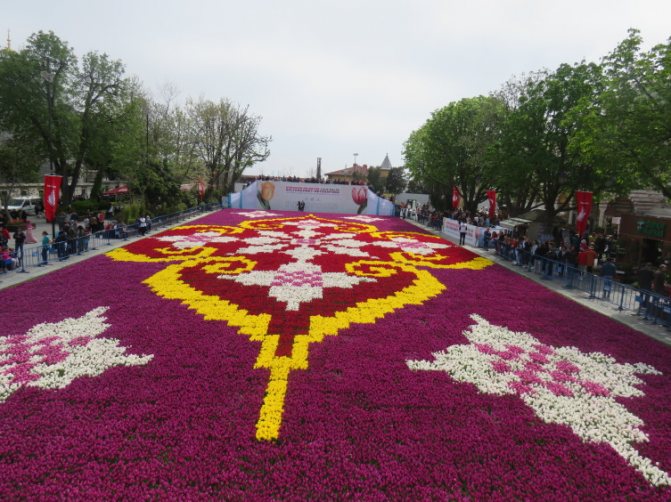

Traditional tulip carpet in Sultanahmet Square. 565 thousand tulips were used here, the area is 1734 sq. m Photo: Olga Lukyanchik
At the end of the 16th century, tulips found their way to Holland, quickly becoming favorites among flowers, and in Europe there was an imperceptibly mistaken opinion that Holland was the birthplace of tulips. Turkey decided to break this stereotype and regain the glory of the country of tulips, reviving the old national traditions of venerating the country's symbol.
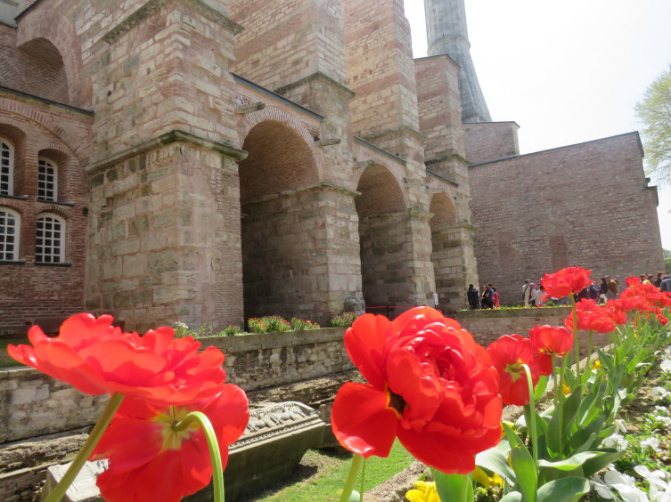

In the courtyard of Hagia Sophia Photo: Olga Lukyanchik
In 2005, it was decided to hold a tulip festival in Istanbul every spring under the motto: "The most beautiful tulips on Earth grow in Istanbul." In preparation for this festival, a huge number of tulip bulbs are planted in the city - more than 10 million!


Blue Mosque Photo: Olga Lukyanchik
The bulbs for the festival are grown in the ancient city of Konya in the south of the central part of Anatolia and in the suburbs of Istanbul. And although the old varieties have lost over time, Turkish breeders have managed to revive some types of tulips with an unusually thin flower with pointed, like a saber, the ends of the petals - practically descendants of the Ottoman tulip.
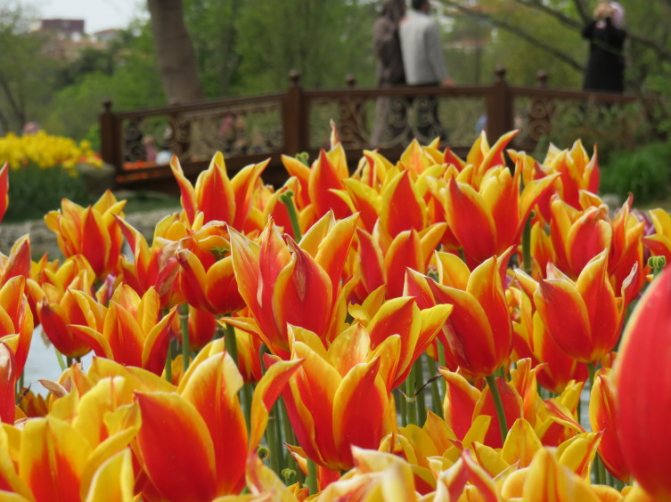

Ottoman tulips Photo: Olga Lukyanchik
In the spring, during the festival, Istanbul becomes the real capital of the kingdom of tulips - they bloom absolutely throughout the city: dozens of varieties of the most varied colors and shapes are planted in parks and city alleys, on street lawns and on city flower beds. They are planted in the soil in strict rows, taking into account the flowering time - from early varieties to later ones, in order to prolong the flowering of each flower bed as long as possible.


Fatih microdistrict Photo: Olga Lukyanchik
Read also: Blue plus yellow what
But not only flower beds decorate city streets these days. Especially for the holiday, local craftsmen make painted sculptures of tulips, which are placed around the city. On some squares, stages are set up for the performances of artists, exhibitions and competitions of flower arrangements and photographs are held. Fairs are opened for the sale of tulip bulbs of various varieties and types, and for amateur flower growers a certain time is allocated and the bulbs are sold at quite affordable prices.
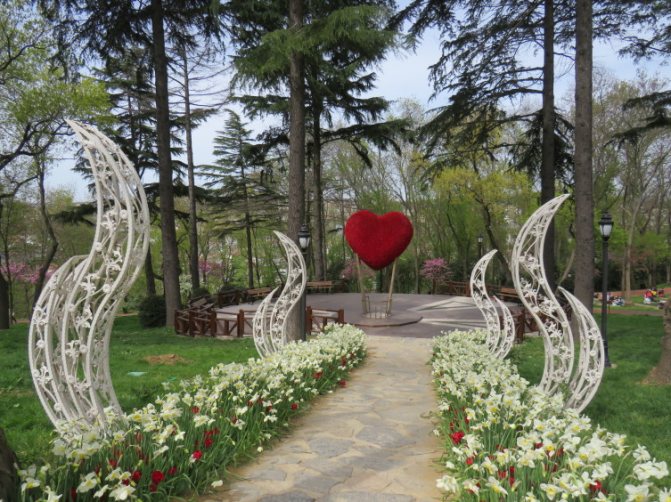

Emirgan Park Photo: Olga Lukyanchik
But the main place during the tulip festival is the Emirgan Park, it is here that all the official events of the festival take place and here almost 2 million tulips are planted in magnificent meadows, combined into delightful compositions of more than 100 species and varieties.


Taksim Square Photo: Olga Lukyanchik
Every year Turkish landscape designers come up with unexpected flower paintings and figures, combining tulips with other spring flowers, creating both simple panels and intricate paintings from fresh flowers. A flowerbed in the shape of the flag of Turkey is necessarily made of scarlet tulips. And also a flower panel in the form of the flag of Holland is being created - as a tribute to another leader in the cultivation of tulips.
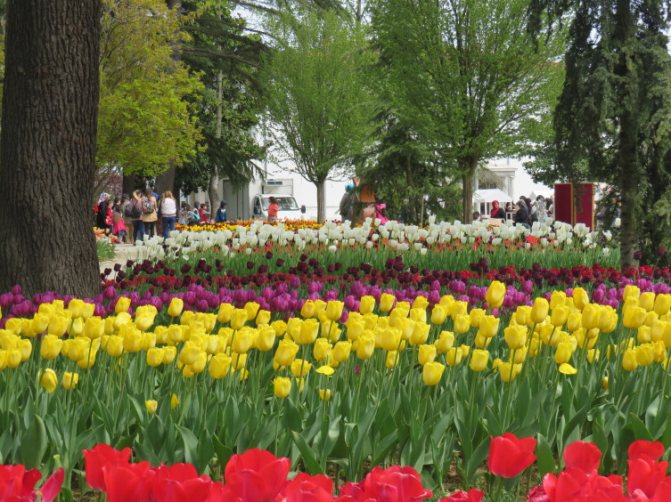

Emirgan Park Photo: Olga Lukyanchik
Breeders from many countries come to the festival to evaluate new varieties, which are annually presented by Turkish colleagues for the judgment of spectators and specialists. And serious work is being done in this direction. In 2013, during the next festival in Istanbul, a tulip museum and a large research center were opened, which houses permanent and temporary exhibitions, halls for scientific meetings and conferences, and a library. All of this is intended to provide visitors with a wealth of information on the importance of the tulip in the history and culture of Turkey.


Emirgan Park Photo: Olga Lukyanchik
However, to admire the flowering of tulips, it is not necessary to get to the Emirgan Park. After all, the whole city is involved in this holiday, these days it is especially beautiful! You can visit other parks as well.
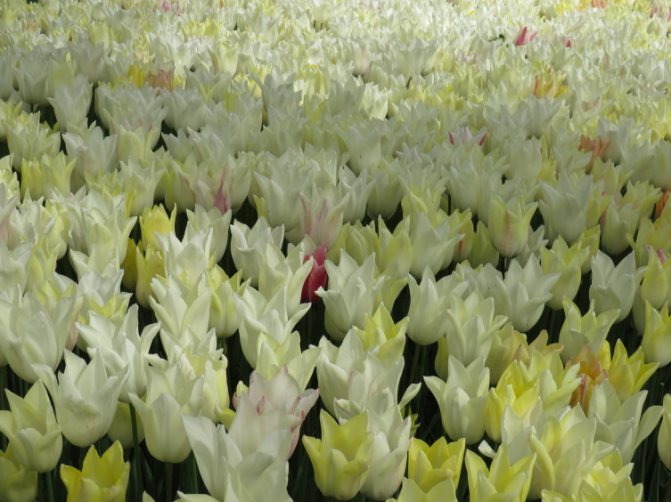

Emirgan Park Photo: Olga Lukyanchik
For example, located in the center of Istanbul, the ancient Gulhane Park near Topkapi Palace.A long time ago, this luxurious corner of nature belonged to the Sultan's palace, only the Sultan and his entourage had access here. In 1863, the park was badly damaged by a severe fire, became public and fell into disrepair.
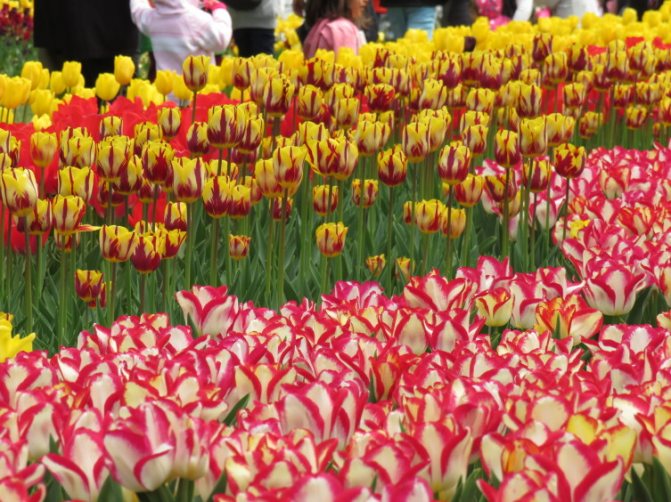

Emirgan Park Photo: Olga Lukyanchik
But in 2003 the park was reopened after a thorough restoration - the previous landscapes were restored, the trees were put in order, the meadows are dotted with flowers. Now Gulhane Park is a favorite place for romantic walks, where the bright floral palette of festival tulips passes the baton to thousands of rose bushes of various types and varieties by summer.
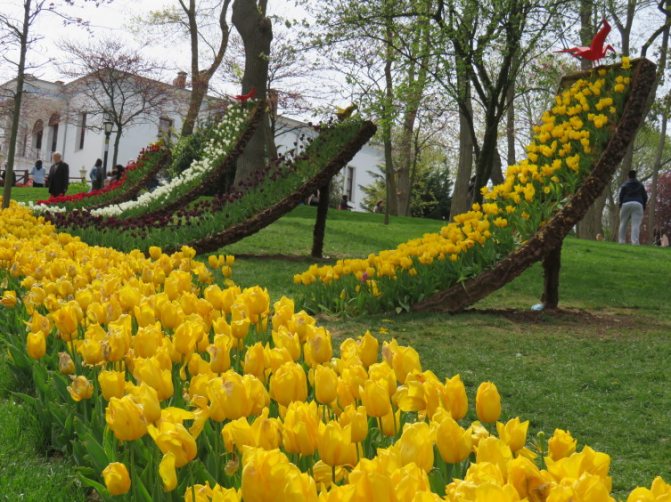

Emirgan Park Photo: Olga Lukyanchik
In the center of the city, in the Besiktas district, there is the Yıldız Park, which houses more than 500 thousand tulips under its crowns, a pond, playgrounds, a mini golf course - everything for interesting leisure of visitors.
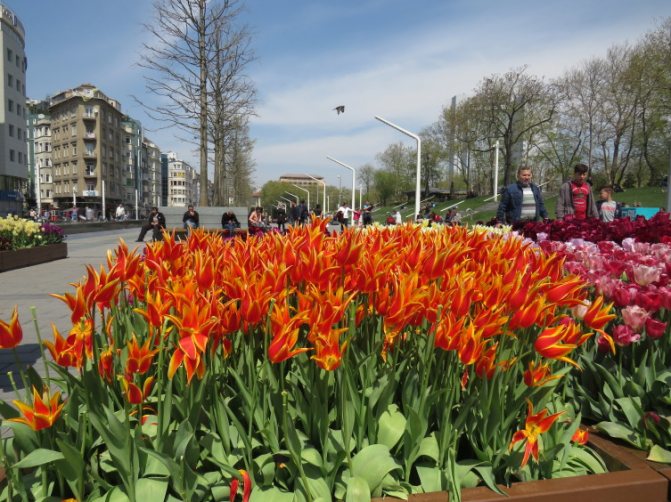

Taksim Square Photo: Olga Lukyanchik
Beykoz Park is located in the Asian part of Istanbul - a wonderful corner of nature, almost a forest. About 600 thousand tulips are planted here, which you can admire, enjoying the fresh air and birdsong.


Emirgan Park Photo: Olga Lukyanchik
So, if you want to get to the tulip festival in Istanbul, keep in mind that there is no specific start and end date for the festival - it is set annually by the organizers. As a rule, this is the entire month of April, plus or minus a week, that is, the very peak of tulip blooming.
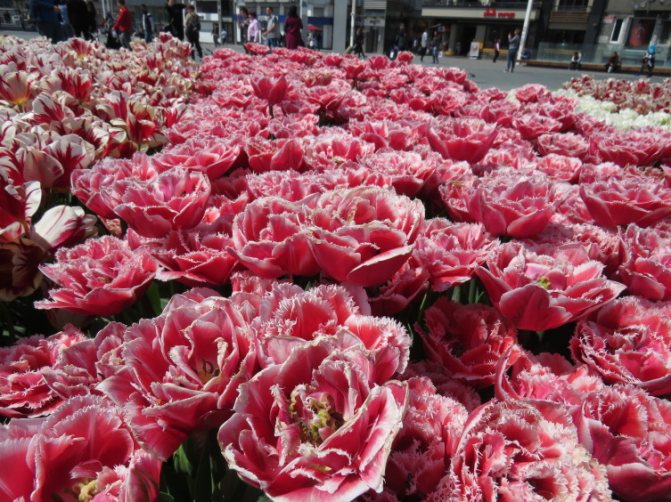

Taksim Square Photo: Olga Lukyanchik
By the way, in 2020, the 13th Tulip Festival takes place from April 12 to 30. These are the official dates, but the tulips will be blooming for a few more weeks.
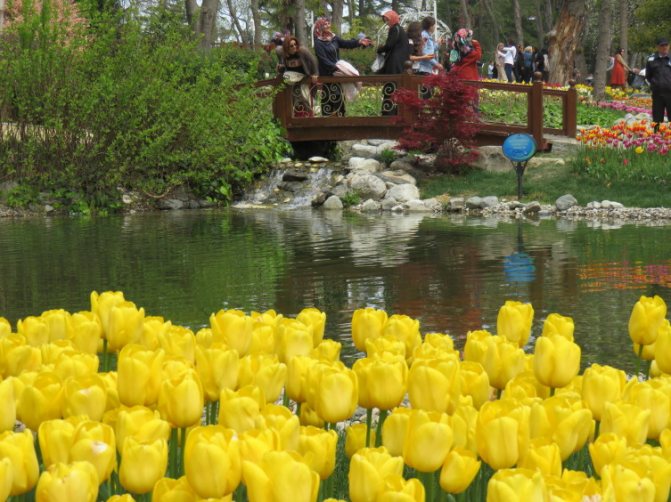

Emirgan Park Photo: Olga Lukyanchik
In Istanbul this year 30 million tulips of 125 varieties have been planted! Tourists have a lot to see!
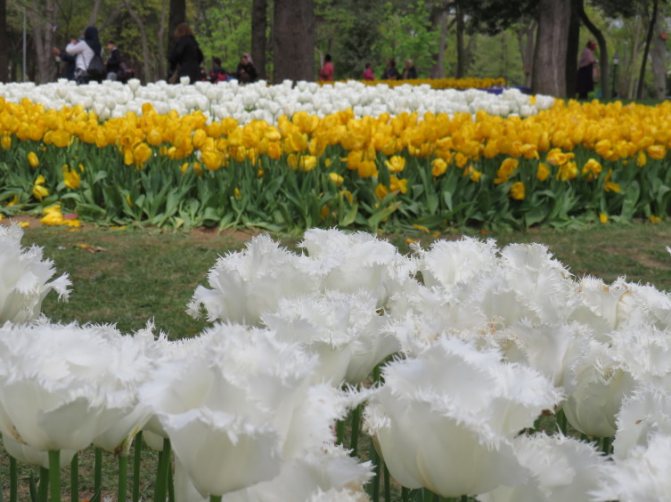

Emirgan Park Photo: Olga Lukyanchik
How is it? Are you ready for a trip and an unforgettable experience? Then something else to note ... The tulip is not just the national flower of Turkey, an ancient legend says that happiness is hidden at the bottom of this flower. Arriving in Istanbul for the festival, be sure to look into a tulip flower - and sunny Turkey will certainly give you happiness!


Emirgan Park Photo: Olga Lukyanchik
Tags: tulips, Turkey, flowers, tulip festival, Istanbul, national traditions, symbols, travel
Common tulip - the birthplace of the plant
Tulips are perennial flowers that belong to the Liliaceae family, the monocotyledonous class and the Tulip genus. In Europe, the word "tulip" came from the Ottoman-Persian dictionary and means the fabric for the national headdress. After all, the flower petals are incredibly delicate and pleasant to the touch.
Tulips are considered the most famous spring flowers, and everything is considered to be the homeland of Central Asia, or rather Persia, but today you can find many types of tulips in Kazakhstan, Turkey, India, Europe, etc. By the way, in Turkey, already in the 16th century, more than 300 species of plants such as tulips were known.


Common tulip
Holland is the main supplier of most flowers. And already in 1702, during the reign of Peter I, an agency was created, whose duties included the supply of flowers from Holland.
Multiflorous tulips: grow properly
Buy only large bulbs - first or "extra". It is highly likely that the small ones will give underdeveloped buds or single flowers in the first year. The diameter of a good bulb of a multi-flowered variety is at least 4 cm. Planting in loose, nutritious, well-drained soil is a general rule for bulbous, with which you, of course, are familiar. In the case of multi-flowered tulips, its observance is especially important: for good flowering next year, they need to be intensively "fattened" during the growth period. If the plants do not form a large mass of roots, or too heavy soil will restrict oxygen access to them, or the plant will experience an excess (lack) of moisture, increased feeding will be useless - the nutrients will not be absorbed by the plant. The soil should be moisture-absorbing, but loose, with a generous addition of well-decomposed organic matter and good drainage.
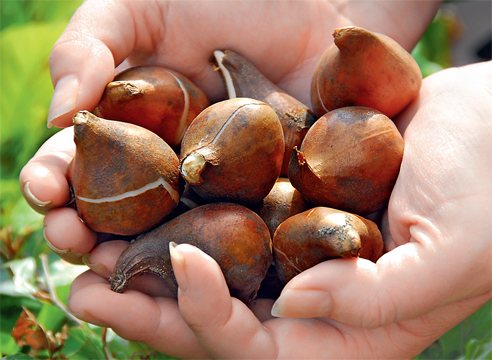

Forget about tulips not being watered. Multiflorous watered! From the moment the snow melts to flowering, the soil in the root zone should be moderately moist.Often it is the spring drought that prompts plants to get rid of the rudiments of "extra" flowers, and the next year the flowering is weak. Do not neglect feeding. Three times the feeding recommended for all tulips is sufficient for multi-flowered varieties. It is only important that you actually do it. In spring, scatter full mineral fertilizer (40-50 g per square meter) over the melting snow, when buds appear, apply fertilizer again in the same dose (before watering), and during mass flowering on wet soil, feed with a solution of potassium monophosphate (tablespoon without a slide for a bucket of water, solution consumption - half a bucket per square meter). Remove ovaries as early as possible after flowering. Only the head is removed - the stem is left in place. This causes the outflow of nutrients from the aerial part of the plant into the bulb and helps it gain strength for flowering next year. Dig up the bulbs annually after the foliage turns yellow. For full flowering, multi-flowered tulips need a deeper and longer summer heat than ordinary tulips. After digging, store the bulbs at a temperature of + 30 ... + 32 ° C for at least 30 days. In early August, move them to a cooler room, such as a shed or shed, where the temperature is slightly higher than outside. Here the bulbs will gradually cool: from + 22 ... + 18 ° С in August to + 10 ... + 15 ° С by the end of September, when the time comes to plant them.
A Tulip Story for Younger Schoolchildren
Story for 1-2 grade. Tulip Sergeev Alexander, 2nd grade student of the Nikolskaya secondary school of general education, Kurchatovsky district, Kursk region. Leader: Shapovalova Irina Ivanovna, primary school teacher of the Nikolskaya secondary school of general education, Kurchatovsky district, Kursk region. Purpose of work: the work will be useful for elementary school students, help them learn more about the tulip. Tulips are spring flowers. They come in different colors, different shapes. For a tulip to bloom in spring, its bulb must be planted at the end of summer.
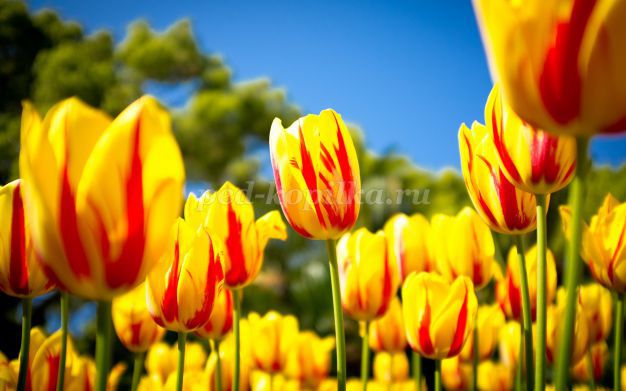

The homeland of the tulip is the country of Holland. There are also a lot of them in our country. Almost every house is full of these flowers in spring.
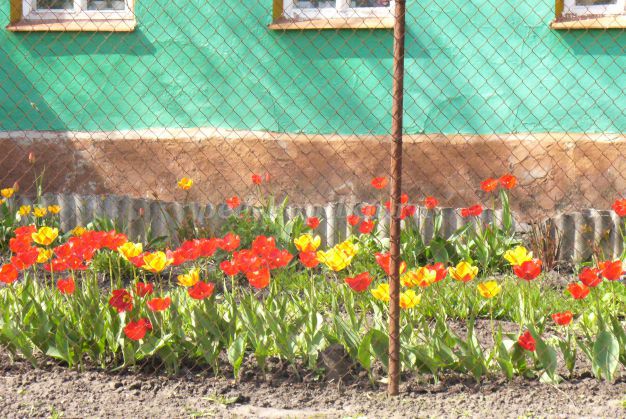

There is a legend about the tulip. In ancient times, it was believed that happiness is hidden in the golden bud of a yellow tulip. Many people have tried to open this bud in order to achieve happiness. But no one was able to do this.
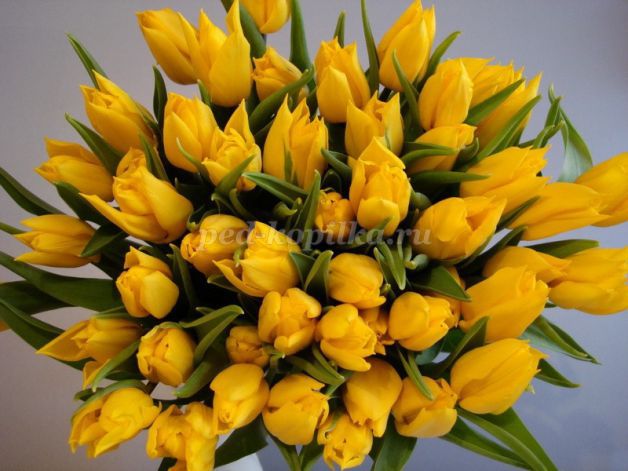

Once a woman with a child was walking in the meadow. The boy escaped from his mother's hands and ran to the flower with a laugh. And from the sonorous laughter of children, the bud opened. Since then, it has been customary to give tulips to those who are happy. Many poems have been written about tulips: A delicate tulip petal He folded his palms, In a bouquet a flower clings to a flower On a delicate fragile leg.
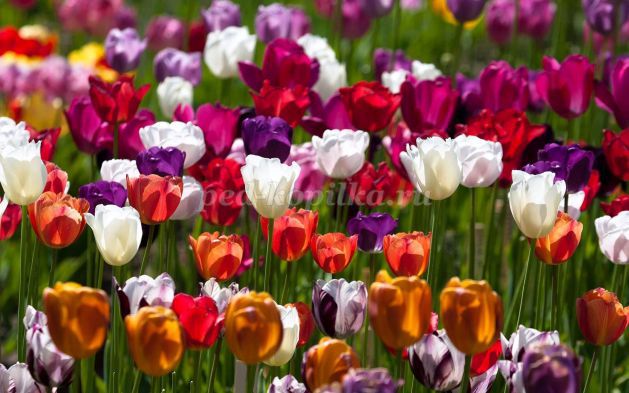

Tulips are wondrous flowers ... Whoever saw the spell knows them ... From all the unsurpassed beauty ... Soul and heart simply freezes ...
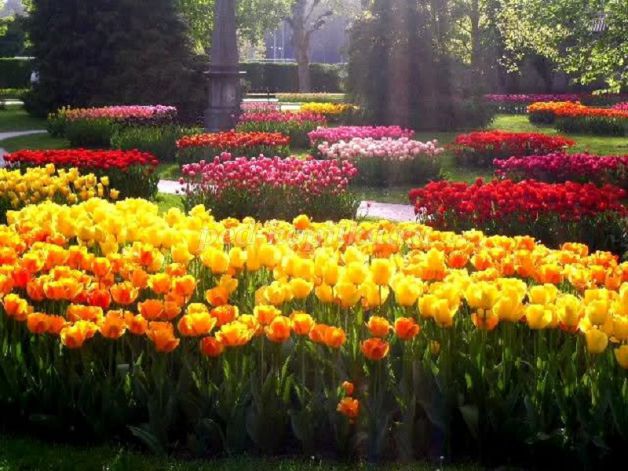

On May 9, we bring tulips to the graves of the dead soldiers with gratitude that they gave us happiness - to live under a peaceful sky.


We recommend watching:
Foil weaving. Master class "Tulips" Story about bird cherry for younger schoolchildren Story about chamomile for children 5 - 8 years old



